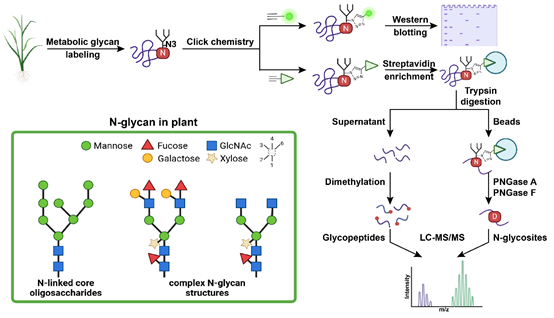Click chemistry, a highly selective and efficient reaction, is widely used in organic synthesis, material science, and biological research. Carolyn R. Bertozzi and two other scientists received the 2022 Nobel Prize in Chemistry for their discovery of click chemistry and its biological applications. One key reaction in click chemistry is the cycloaddition between azide groups (–N₃) and alkynes (–C≡C), forming stable 1,2,3-triazole structures. However, there has been little research on its application to N-glycosylation in crops.
Recently, a team led by Academician Jiayang Li from the Institute of Genetics and Developmental Biology, Chinese Academy of Sciences/Yazhouwan National Laboratory, in collaboration with Professor Xing Chen from Peking University, published a paper titled 'Chemical glycoproteomic profiling in rice seedlings reveals N-glycosylation in the ERAD-L machinery' in Molecular & Cellular Proteomics (https://doi.org/10.1016/j.mcpro.2024.100883). This study marks the first systematic identification of N-glycosylated proteins in rice using click chemistry. It offers new insights into their functions.
N-glycosylation is a widespread and crucial post-translational modification involved in protein folding, transport, and function, essential for plant growth, development, and stress responses. Rice, a staple food for nearly half the global population, is vital for food production. With rising global population and improving living standards, the demand for higher rice yields and quality has increased. Research indicates that N-glycosylation impacts processes like root development, tillering, and grain weight, thereby having a profound impact on rice growth and yield. However, due to the complexity of plant N-glycosylation and limitations in identification technologies, progress has been slow in crops like rice.
The recent study combined click chemistry with metabolic glycan labeling (MGL) to analyze the N-glycoproteome in rice seedlings. After testing different monosaccharide analogs, N-azidoacetylgalactosamine (GalNAz) was selected for labeling. Using click chemistry, the researchers enriched GalNAz-labeled glycoproteins and identified 403 N-glycosylation sites and 673 N-glycosylated proteins by mass spectrometry, with 519 proteins newly identified. These proteins are involved in key biological processes, and the study showed extensive N-glycosylation of core components in the endoplasmic reticulum-associated degradation (ERAD) pathway, crucial for the ERAD-L machinery's function. Further analysis revealed that this N-glycosylation modification is conserved across plants and animals. Building on their previous work introducing MGL into rice glycobiology (Li et al., 2023), this study extends MGL's application in crop glycoproteomic analysis and provides valuable resources for rice N-glycosylation research.
This research was funded by the National Natural Science Foundation of China, the specific research fund of The Innovation Platform for Academicians of Hainan Province, the Hainan Excellent Talent Team, the Basic Research Project of Yazhouwan National Laboratory, and the Xplorer Prize Award.
Click Chemistry-Based Identification of N-glycoproteome in Rice Seedlings (Image by IGDB)
Contact:
Dr. LI Jiayang
Institute of Genetics and Developmental Biology, Chinese Academy of Sciences/Yazhouwan National Laboratory
Email: jyli@genetics.ac.cn
 Click Chemistry-Based Identification of N-glycoproteome in Rice Seedlings (Image by IGDB)Contact:Dr. LI JiayangInstitute of Genetics and Developmental Biology, Chinese Academy of Sciences/Yazhouwan National LaboratoryEmail: jyli@genetics.ac.cn
Click Chemistry-Based Identification of N-glycoproteome in Rice Seedlings (Image by IGDB)Contact:Dr. LI JiayangInstitute of Genetics and Developmental Biology, Chinese Academy of Sciences/Yazhouwan National LaboratoryEmail: jyli@genetics.ac.cn CAS
CAS
 中文
中文




.png)
